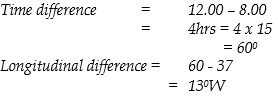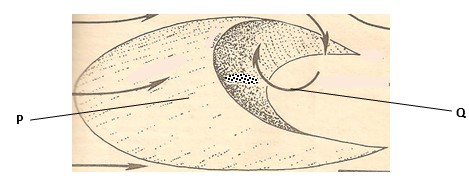Question 1
- State three characteristics of sial.
- Outline two characteristics of the troposphere.
Answer
- - Forms the continental crust/upper crust.
- Consists mainly of silica and aluminium.
- Sial is made up of light rocks/2.7g/cc / floats on sima.
- Sial is made up of granitic/ sedimentary/ metamorphic rock.
- Contains 75% of the total gaseous mass of the atmosphere.
- 90% of water vapor found in this layer.
- Sial is made up of rigid/brittle rocks. - - Most weather phenomena occur in this layer.
- Contains the weather making constituent/life supporting layer.
- Temperature decreases with increase in altitude (positive lapse rate)/ rate of 6.50C per 1000m.
- Pressure falls with increase in height.
- Rises to about 15km above the surface of the earth.
- Contains most of the atmospheric water vapour, cloud, dust/pollutants (hence unstable).
Question 2
- What is a longitude?
- What is the longitude of station X when it is 8.00 a.m. where in Nairobi at longitude 370E is 12.00 noon?
Answer
- - This is the angular distance showing how far a place is west or east of the prime meridian/
- An imaginary line on the map/globe running from North pole to south pole showing how far a place is west or east of the prime meridian. -

Question 3
- State three causes of earth movements.
- Name two main earthquake zones in the world.
Answer
- - Istatic adjustment
- Gravitative pressure
- Magma movement within the crust.
- Convectional currents in the mantle - - The curcum pacific belt
- The mid atlantic ridge
- Mediterranean - Himalayan belt
- Rift valley
Question 4
- Name two features found on emerged high land coast.
- State three conditions necessary for the formation of a spit.
Answer
- - Raised cliffs
- Raised wave cut platform
- Raised beaches
- Raised caves
- archs
- Stacks, stumps
- Blow-holes
- Geos - - The waves must carry large amount of load/ ample supply of sand being transported.
- The long shore drift must be weak
- It must be a shallow shore/continental shelf
- Waves must have a strong swash and weak backwash/constructive waves.
Question 5
- The diagram below shows a barchan

(i) Name the feature marked P.
(ii) Name the wind marked Q. - How is a deflation hollow formed?
Answer
- (i) P - Gentle slope.
(ii) Q - Eddy current - - Pre-existing depressions/localized fault is deepened by eddy action.
- Gradually the depression is excavated through removal of the unconsolidated materials by wind abrasion/by deflation.
- The depression is deepened then eddy currents develop causing more erosion.
- The depression is a deflation hollow.
